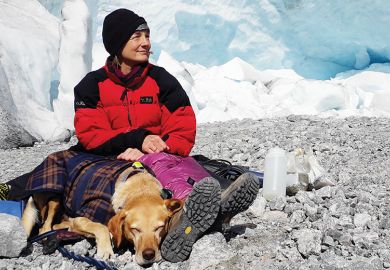Glancing at the frontispiece of Thomas Gold's The Deep Hot Biosphere , proclaiming "a renowned scientist's theory of a vast subterranean habitat",the reader could be forgiven for thinking a literary voyage similar to that of Jules Verne's A Journey to the Centre of the Earth awaits him. And just as Verne's classic is nothing other than a damn good yarn, so it is with The Deep Hot Biosphere , despite Freeman Dyson's introductory eulogy portraying Gold as a man struggling valiantly against the dogma of orthodox science, in this instance geology.
Gold's book contains two central yet complementary ideas: the petroleum deposits of the world are not biogenic in origin, and the earth's lithosphere harbours a second, "extremophile" biosphere. But just as Verne's explorer Professor Lidenbrock, when forced to choose between two tunnels on his way to the earth's interior, initially takes the wrong path,so it is with Gold's theories. One, concerning petroleum geology, leads to a dead end. The other, that a primitive domain of microbial life exists in the pore spaces of rocks at depth, may demand a major reassessment of how life on earth evolved.
The Deep Hot Biosphere is largely an expansion of ideas set out by Gold in a 1992 paper of the same title, published in the highly respected US journal Proceedings of the Natural Academy of Sciences . The original manuscript was submitted to Nature but rejected. It is true that novel and provocative papers can fall foul of the peer-review system, but it found a home in the Proceedings , because, as Gold himself admits, he was able to nominate two friends guaranteed to give it favourable reviews. The paper, and the book that followed, are a mix of the insightful and the incredible.
Let me start with the incredible. The basis for Gold's assertion that hydrocarbons on earth are primordial comes from studies of meteorites and spectroscopic examination of interstellar space, both of which contain hydrocarbons produced inorganically. In the Gold model, hydrocarbons become incorporated and trapped within accreting planetary lithospheres, occasionally seeping to the surface where, in the case of the earth, they are oxidised to carbon dioxide and water. According to Gold, the carbon dioxide inventory of the earth's atmosphere and the water in its oceans is formed largely by this mechanism.
The abiogenic theory of hydrocarbons rests on five assumptions. Brevity prevents a detailed analysis, but two of them, that the earth has undergone only partial (as opposed to wholesale) internal melting and that rocks at depth contain pore spaces, were last contentious in the 1950s. The fact that both are held up as near-revolutionary ideas shows just how out of touch Gold can be with current thought. Thermodynamic arguments for the stability of hydrocarbons at depths of up to 600km are based on work by Russian scientists. Gold is fond of Russian scientists who, inspired by Mendeleyev, have believed in a deep origin of hydrocarbons for over a century.
The truth is that evidence for a biological origin for the vast majority of natural hydrocarbons, including stable isotope data, relative abundance of alkane species, optical properties and direct fossil evidence, is overwhelming. In this aspect, the reaction of the minerals industry to Gold's ideas is revealing. It is no secret that petroleum companies answer to their shareholders, who do not give a hoot where oil forms, so long as it can be extracted at a profit. Gold's big chance to prove the biological origin of hydrocarbons wrong ended in failure. However, reading his book one could be mistaken for thinking that the drilling of the Siljan Ring, crystalline basement rock and the site of a meteor impact, was an unqualified success. This is not so: the Swedish government pulled the plug after 6.5km of drill core failed to produce the promised rush of black gold. Much is made of the hydrocarbons in crystalline rocks, as if this were clinching proof of his abiogenic theory for their origin, but the silence of the drills is stark. It would be a bold corporation that embarked on exploration of crystalline basement (allegedly fingers were burnt in the Siljan Ring project) in search of petroleum deposits. Methane-bearing fluids can be generated inorganically in crystalline igneous rocks by vapour-mineral surface reactions, but not in sufficient quantities to be economically viable.
Now to the insightful. Before setting up his theory of a deep biosphere, Gold reviews the extraordinary discovery in recent years of thermophilic microbial communities living around deep-sea vents on the ocean floor that have adapted to extreme temperatures and pressures. How did these organisms get there? One explanation is that they are highly specialised forms of ancestral surface dwellers. Gold disagrees. According to him, the majority of the biomass of our planet resides not at the surface (ie the land and oceans), but within the solid outer lithosphere of the earth, extending to a depth of 5-10km. This life is in the form of primitive archaebacteria, which obtain energy not from the sun, like the photosynthetic surface dwellers, but from oxidation of hydrocarbons seeping upwards from still deeper levels. Oxide and sulphate minerals provide the required oxygen. This may explain his continued opposition to hydrocarbons as fossil fuels - Gold's bugs eat oil! Their dead hopanoid remains contaminate oil, fooling us surface chauvinists into accepting a biological origin. A conservative estimate of this biomass is 2 x 1014 tons, more than the combined fauna and flora of the earth. In 1992 this seemed fanciful, but recent discoveries of bacteria living in deep-sea sediments and continental rock to depths in excess of 1,000m has thrown the field of geomicrobiology into open speculation. And with controversy over suggested fossils in the Martian meteorite ALH84001, Gold's suggestion that meteorite interiors should show signs of life seems almost prophetic.
So, is Gold a 20th-century Professor Lidenbrock? There do appear to be some uncanny similarities between both savants. They are men of certitude and bold ideas, and they appear as often wrong as right. Gold's ideas on hydrocarbon formation continue to rub against the grain, and his arguments in favour of a purely abiogenic origin remain unconvincing. Some of Gold's other ideas on inorganic coal, Olympus Mons on Mars as a giant mud volcano,gas-driven earthquakes, and the occurrence of mineral deposits test the very limits of credulity. On the other hand, his claim for the existence of a deep extremophile fauna may turn out to be right. Do the warm, protective interiors of the earth and similar terrestrial planets harbour an unseen biosphere? Unlike abiogenic petroleum, this cannot be ruled out. Just as Lidenbrock and his companions found the letters AS carved into subterranean rock, future explorers of the lithosphere may yet be confronted by the initials TG.
Nick Petford is senior lecturer in geology, Kingston University.
The Deep Hot Biosphere
Author - Thomas Gold
ISBN - 0 387 98546 8
Publisher - Copernicus
Price - £19.00
Pages - 235
Register to continue
Why register?
- Registration is free and only takes a moment
- Once registered, you can read 3 articles a month
- Sign up for our newsletter
Subscribe
Or subscribe for unlimited access to:
- Unlimited access to news, views, insights & reviews
- Digital editions
- Digital access to THE’s university and college rankings analysis
Already registered or a current subscriber?



